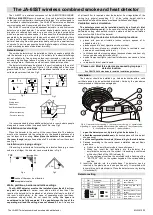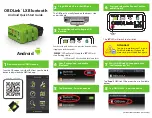
Chapter 6
6-8
BiPAP Vision Service Manual © Respironics, Inc.
1062788
Troubleshooting
6.3 Alarm
Troubleshooting
Table 6-2 describes alarms, including possible causes and corrective actions.
Table 6-2: Troubleshooting Alarms
Alarm display
Description
Possible cause
Corrective action
Check ventilator indicator:
audible and visual indicators
active, ventilator continues
operation.
System error
See Section 6.4 for
Check Vent
troubleshooting information.
Ventilator inoperative
indicator: system failure
(device malfunction) or AC
power failure (power is lost
when the power switch is ON).
Device shuts down, valves
open to atmosphere to permit
spontaneous breathing,
audible and visual indicators
active, audible alarm cannot
be silenced.
Failure that impairs
ventilator performance.
See Section 6.5 for
Vent Inop
troubleshooting information.
AC power failure
1. Verify input power.
2. Check fuses.
Thermal fuse activated
(non-resettable).
Replace transformer.
No bulk supply voltage.
Replace PSS.
Apnea
No spontaneous breath
triggered within set apnea
interval. Cancels when patient
triggers 2 consecutive
spontaneous breaths. Apnea
alarm can be disabled.
Patient not breathing or
cannot trigger a
spontaneous breath.
1. Check patient.
2. Check patient circuit.
3. Review apnea alarm limit.
Disconnect
Mask removed or excessive
leak. Cancels if leak is
corrected.
Mask or circuit removed
or dislodged
Check patient circuit and mask.
Exh. Port
Low leak during exhalation:
activates when leak during
exhalation falls to 5 L/min or
50% of alarm limit for 1
minute.
Air flow path blocked or
restricted.
Check air flow path.
Hi P
High pressure: proximal
pressure exceeds the high
pressure alarm limit for over
0.5 s. Ventilator terminates
inspiration. Cancels if
pressure during a subsequent
breath is below the high
pressure limit.
• Patient coughs during
inspiration.
• High pressure alarm
limit set below
pressure setting.
1. Check patient.
2. Review high pressure alarm
limit.
















































